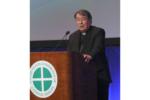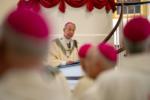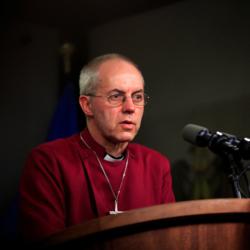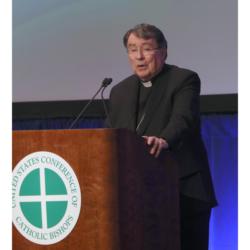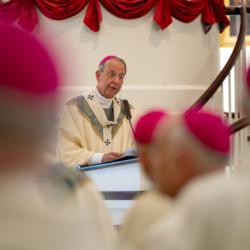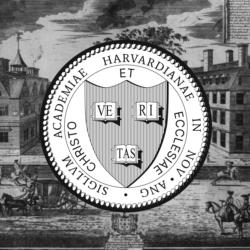Do we have two archbishops?
Yes and no. This is one of those questions that you always wish were on your tests in school. Both answers are correct, as you can see explained under "archbishop."
At one of our staff meetings, we agreed that it might be best to provide readers in this special section with a list of terms that we toss around the office but occasionally need clarification for our readers.
What follows is a list of words, alphabetically arranged, with definitions and explanations that are related to the installation of our new archbishop. I tried to get as many in without straying too much. Similarly, I wanted to keep the list for The Pilot subscribers, as they might encounter the terms in this or other Roman Catholic publications, so I limited it to the Latin Church and to the circumstances we would encounter regarding matters here in the United States.
Administrator
Apostolic -- a bishop, and sometimes a priest, who is appointed by the pope to govern a diocese during the vacancy following the resignation, transfer, or death of the diocesan bishop. The apostolic administrator has wide authority in the governance of the See where he is assigned as administrator. And as it is stated, he governs the See in the name of the Roman Pontiff.
Diocesan -- a bishop or a priest who is elected by the consultors of the diocese during the vacancy following the resignation, transfer, or death of the diocesan bishop. The diocesan administrator, or vicar capitular, has some limits of the authority of a diocesan bishop during the vacancy of the See.
Archbishop
Residential or diocesan -- the bishop who is the chief shepherd of a See that has been recognized as an archdiocese by the pope. On Oct. 31, 2024, Archbishop Richard. G. Henning will be the archbishop of Boston.
Titular -- a bishop who has the title, but not the governance, of a formerly existing diocese. This title is usually for bishops who are members of the Roman Curia, or active or retired members of the Holy See's diplomatic corps. Sometimes, a titular archbishop could be the auxiliary bishop in a diocese.
Senior -- once a bishop reaches his 75th birthday, he is expected to submit a resignation letter to the pope. When the pope accepts the request and it is announced, the bishop becomes emeritus of his last diocese. Titular bishops retain their title but no longer have an office. In both cases, they remain bishops. On Oct. 31, 2024, Cardinal O'Malley will cease to be the archbishop of Boston and becomes archbishop emeritus.
Designate and elect -- from the moment a priest is named a bishop, and until his episcopal ordination, he is called bishop-elect. If a bishop is already ordained and is transferred to another diocese, he is bishop-designate.
Bishop
Residential or diocesan -- a bishop who is the chief shepherd of a diocese and has been so appointed by the pope.
Titular -- a bishop who has the title of a previously existing diocese; all our auxiliary bishops, both active and senior, are titular bishops.
Their equivalents in Canon Law -- we don't have any of these in the United States, but a bishop may govern a territorial abbey, a territorial prelature, or a vicariate apostolic. They are all like dioceses, but the Holy See is waiting for them to develop before possibly making them dioceses.
Senior -- once a bishop reaches his 75th birthday, he is expected to submit a resignation letter to the pope. When the pope accepts the request and that is announced, the bishop becomes emeritus of his last diocese. Titular bishops retain their title but no longer have an office. In both cases, they remain bishops.
Designate and elect -- from the moment a priest is named a bishop, and until his episcopal ordination, he is called bishop-elect. If a bishop is already ordained and is transferred to another diocese, he is bishop-designate.
Cardinal
A title of honor given by the pope to selected clerics, usually bishops, but sometimes priests, which connects them in a special manner to the Diocese of Rome and to the pope. There are three ranks for cardinals, but for the most part, they all have similar responsibilities, especially electing a new pope. They are visible because of the scarlet robes. On their 80th birthday, cardinals lose their right to vote in a papal election. Unless the pope might decide otherwise, they also lose their membership in the dicasteries of the Roman Curia.
Bishop -- these cardinals, all of them are bishops, who have the title, but no governance responsibility in the Sees that surround the Diocese of Rome. They are usually heads of dicasteries of the Roman Curia. There are currently no Americans who are cardinal bishops.
Priest -- these are cardinals, all of them are bishops, who have a title to a parish in the Diocese of Rome. They do not govern their Roman parish but usually maintain an active interest in it, visit it, and celebrate Mass there when in Rome. They keep the title until their death, unless transferred by the pope to another title or promoted to cardinal bishop.
Deacon -- these are usually bishops but sometimes priests who have been made cardinals, and usually because of their age, have been dispensed from being ordained bishops as is usually expected of cardinals. Their titles are of the deaconries in Rome, which are usually parishes designated as deaconries.
Deacon
Permanent -- the third of the three ranks of Holy Orders, deacons are ordained to the ministry of word, sacrament, and charity: but not to the priesthood. Permanent deacons remain deacons through the rest of their lives; they may be married or single.
Transitional -- like permanent deacons in responsibility; except, these deacons, are to be ordained to the presbyterate usually within a year of their having been ordained a deacon.
Metropolitan
These are archbishops who are appointed by the pope to an archdiocese that has Suffragan Sees. In fact, it is the existence of a Suffragan See that makes an archdiocese a Metropolitan See. The Metropolitan See is made so by the pope, and he assigns the Suffragan See to it. The metropolitan has some very limited responsibility over the suffragans.
Monsignor
A title given to clergy by the pope in recognition of their service to the Church. They are nominated by the pope on the recommendation of their diocesan bishop. All of them may be addressed as Reverend Monsignor, the difference is in their vesture.
Protonotary -- The letters PA may be placed after the family name. As regards choir dress: they are entitled to wear purple (more properly amaranth, a shade of fuchsia/magenta) cassock and sash. On more formal occasions, they, alone of all grades of monsignor, may use the black biretta with purple tuft and the purple ferraiolo. For house attire, they may wear the black cassock, piped in purple with purple buttons and the purple sash. They no longer have use of the black zucchetto with red cording, nor the purple tufted biretta.
Prelate of honor -- For choir dress, they may use the purple (more properly amaranth, a shade of fuchsia/magenta) cassock and purple sash as well; while their house attire is the black cassock with purple piping and buttons and purple sash. They may no longer use the purple ferraiolo, nor the purple tufted biretta.
Chaplain of His Holiness -- For both choir and house attire, they may use the black cassock with purple (more properly amaranth, a shade of fuchsia/magenta) buttons and piping with purple sash. The current practice of the Holy See is to name only chaplains for those outside the Roman Curia and the diplomatic corps of the Holy See.
Ordinary
A bishop or priest who has a specific role in a diocese. Every diocese has at least two ordinaries -- the diocesan bishop and the vicar general. Most have several others, as for example, episcopal vicars who are also ordinaries. It is better to refer to the bishop of your diocese as diocesan bishop rather than ordinary. Cf. below "Vicars."
Papal representative
The pope sends representatives, as other nations send ambassadors, to various nations. If, as in the case of the United States, the representative is sent both to the nation and the Church in that nation, he is a nuncio; if he is sent as a representative exclusively to the Church in a nation, he is an apostolic delegate. Since 1984, the Holy See has sent a nuncio to the United States of America, currently Christophe Cardinal Pierre.
Pastor or parish priest
The priest appointed by your bishop to lead your parish is the pastor. He's your priest. Sometimes on an interim basis, the bishop will appoint a priest as administrator of the parish, until determination is made about a pastor. In the United States, if the bishop wishes, can be appointed to terms, which are six years and can be renewed at the bishop's discretion.
Priest or presbyter
A man who has been ordained by a bishop to the priesthood of the "second rank"; he may be a pastor, a parochial vicar, or assigned to another ministry, e.g., education, military chaplain, hospital chaplain, or campus ministry.
Vicar
A vicar is a cleric who acts in the place of someone else or for someone else. There are several kinds of vicars whom you might meet along the way. To be named any of the following types of vicars, he must be either a bishop or a presbyter.
Episcopal -- a cleric usually a priest but can also be a bishop who is entrusted by the diocesan bishops with responsibility for some defined and limited aspect of the diocese, e.g., a particular geographical area, e.g., a region; an ethnic group, e.g., Latino; or a ministry, e.g., campus ministry, health care.
Forane -- a priest selected by the bishops who serves as a link between him and the priests of the neighboring parishes in a defined area.
General -- the principal assistant of the bishop, he must be either a bishop or priest. He has wide responsibility and governance power across the whole diocese.
Judicial -- a priest or bishop who is the head of the diocesan tribunal. He is the bishop's canon lawyer and is assisted by others in the day-to-day judicial function of the diocesan bishop.
Parochial -- the official name for the associates or even older name for curates in a parish.
Senior -- in Boston, a priest who is close to senior priest or retirement status, but is more a part-time parochial vicar; the arrangement is usually made between the pastor and the would-be senior vicar, the actual assignment is made by the archbishop.
If this looks confusing, it can be. However, look at the organizational charts of any federal or state agency in our country. They make us look clear, neat, and streamlined!




